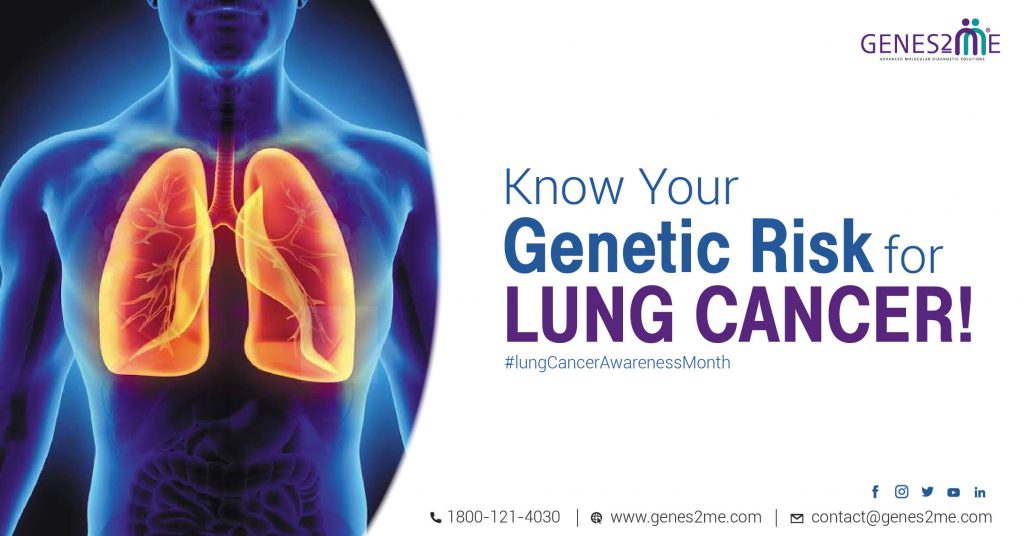Development of Lung Cancer


Generally, the cells in our lungs and other parts of the body have a specific growth and death cycle that normally controls the cell count and keep a check on it. Cancer develops when a certain set of changes/mutations develop in a normal cell. When these sets of mutations affect genes in ways that hinder the natural growth and death cycles of cells, thereby causing unregulated cell division and hence, causing Cancer. Genetic testing for cancer at an early stage helps in reducing the risk of lung cancer.
There are various kinds of cancer, that exist, out of which Lung Cancer is one of the most common ones. Being the second most common cancer in men and the fifth most common cancer in both men and women together, Lung cancer originates from the lung tissue, usually from cells lining the air passages. There are two main types of lung cancer: small cell lung cancer (SCLC) and non-small cell lung cancer (NSCLC). These types are classified on how the cells look like. Around 80% of all lung cancers are non-small cell type. Non-small cell type is further sub-divided into 3 major categories: adenocarcinoma, squamous cell carcinoma and large cell carcinoma.
It can spread to different parts of the body through the blood and lymphatic vessels. This is called metastasis. Nearly 40 % of people who are newly diagnosed with lung cancer already have metastasis to other parts of the body for e.g. lymph nodes, liver, bone, brain, adrenal gland, etc.
Factors affecting Lung Cancer!
Tobacco: Tobacco in any form is harmful, whether smoked or smokeless. Smoking cigarette and beedi is the major risk factor for lung cancer. It increases an individual’s risk of getting lung cancer by 15 to 30 times. The risk of lung cancer increases with the number of cigarettes smoked each day and with increasing duration of time, the person has been smoking. And eventually, the risk decreases if the individual quits smoking.
Tobacco not only affects lung cancer but can also cause cancer anywhere in the body like head and neck region, blood, stomach, liver, pancreas, colon, bladder, kidney, cervix and cancer in the bone marrow.
In India, around 87% of males and 85% of female patients with lung cancer have a history of tobacco smoking and also of passive tobacco exposure.
• Exposure to chemical carcinogens: People having exposure to arsenic, chromium, diesel exhaust, silica and nickel have a high risk of developing lung cancer.
• Indoor burning of coal: Indoor combustion of coal, either for cooking or heating, increases the risk of lung cancer. It results in high levels of indoor air pollution due to a wide range of pollutants that damage health.
• Lung Infection: Having infections like pneumonia or disease like tuberculosis that can lead to scar tissue formation in the lungs may have an increased risk for adenocarcinoma of the lung, a type of lung cancer.
• Lifestyle & Diet: There are some factors that may prevent lung cancer and some which may increase the chances of the same. People with a low intake of foods rich in beta-carotene, such as carrots, have a higher risk for lung cancer. Deficiency of Vitamin A increases the chance of developing squamous cell carcinoma of the lung in smokers.
• History of Lung Cancer: People with a family or a personal history of lung cancer especially in first degree relatives have a higher probability of lung cancer. The risk may be higher if there is a positive family history since they share the same living space. There is a risk of developing lung cancer in the other lung if you have had lung cancer on the other side.
Ways to Fight against Lung Cancer
There’s no sure way to prevent lung cancer, but you can always reduce your risk in some ways:
- Quit smoking: Quitting reduces the risk of lung cancer, even if you’ve smoked for years. There are many strategies and stop-smoking aids that may help you to quit smoking. Options for this include nicotine replacement products, medications.
- Diet: A healthy diet with a variety of fruits and vegetables red. Vitamins and nutrients are the best sources. Avoid large doses of vitamins in pill form, as they may be harmful.
- Exercise: Start doing exercise regularly. Try to exercise and do yoga most days of the week.
- Avoid smoke: If you live or work with someone who smokes, ask him or her to quit, or ask him or her to smoke outside. Avoid areas where people smoke, like bars and restaurants, and seek out smoke-free options.
With some of these ways, one can definitely reduce the chances of getting affected by Lung Cancer and pave a path for a healthy future.
